UNBRIDLED COURAGE TO WALK AGAIN
J.R. Vezain’s story of determination and spiritual strength
WHEN TRIALS BECOME BLESSINGS
Ryle Clark has captured his family’s heart


MORE THAN MAN’S BEST FRIEND
Service dog trainer turns his adversity into a healing movement
WINTER 2020
WHEN TRIALS BECOME
written by Cyd Hoefle
JEAN’S CUISINES written by Jean Petersen
MORE THAN MAN’S BEST FRIEND
written by Brian D’Ambrosia
HUNT TO REMEMBER written by Kayla Walker
KAYLENE AND JOSH BAKER

written by Cyd Hoefle
COURAGE TO WALK AGAIN
by Cyd Hoefle
A LIFE WELL LIVED written by Karen Grosz
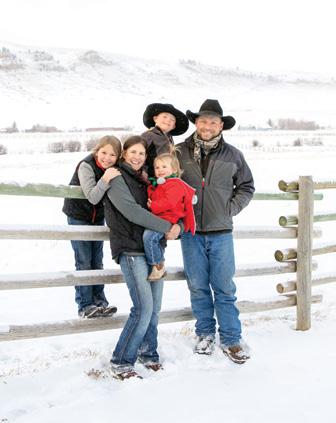


PHOTO BY

contents WINTER 2020 18 3824 PUBLISHER CYD & STU HOEFLE 406-860-0292 // publisher@raisedinthewest.com COPY EDITOR ED KEMMICK ADVERTISING CYD HOEFLE 406-860-0292 // publisher@raisedinthewest.com STU HOEFLE 406-860-4109 DESIGN MELANIE FABRIZIUS ads@raisedinthewest.com ADDRESS RAISED IN THE WEST PO Box 80267 // Billings, MT 59108 ©2020 Peaks to Prairie Media All rights reserved. No part of this publication may be reproduced without written permission from the publisher. 10
BLESSINGS
16
18 A
24 UNBRIDLED
written
32
38
44
www.raisedinthewest.com FOLLOW US! 10 UNBRIDLED COURAGE TO WALK AGAIN J.R. Vezain’s story of determination MORE THAN MAN’S BEST FRIEND Service dog trainer turns his adversity WHEN TRIALS BECOME BLESSINGS COVER RYAN AND LINDSEY CLARK AND THEIR CHILDREN LAINEY, HARPER AND RYLE
PEDERSENS PHOTOGRAPHY 4 // www.raisedinthewest.com
note from the publisher
We can all agree 2020 has been a difficult year. With the daily doses of discouraging news and hardships across our country, we decided to take a different approach with our last issue of the year. As we enter the Christmas season, we felt it was appropriate to fill our magazine with stories that would bring you hope. There are fewer articles this time. They are longer and each is a story of steadfastness lived out by ordinary people whom we have been honored to meet. Courageous, determined, and special describes all of them and their families. We truly have been blessed being allowed into their lives and are honored to tell their stories.
Several of our profiled people were dealt a situation that changed the course of the rest of their lives. Their bravery, dedication and faith propelled them to adjust and keep forging on. Their hope in the Lord evident, the love and support of family unfailing. They each made a decision, to keep going and keep trying. Sure, some days are rough, but as J.R. Vezain told us, “Without hardships, we wouldn’t know the depth of our character.” Well said!
Our cover story is of the Clark family living on a ranch near Absarokee. What a festive, beautiful family they are! We’re proud to have them grace our cover. Their story will warm your heart.
We also found stories of people helping other people, doing what they can to make a difference in someone else’s life. For some, the most difficult situation they ever faced became their ministry and life’s dedication, and they now help others navigate through similar waters.
We hope our Christmas issue will fill you with admiration for the people we were blessed to tell about, but more than that, we hope that you will look at your own situations and know that you can endure. You can persevere, and you can prevail. Hope. It might be the last thing you have left in your situation, but it’s by far the best.
From Raised in the West to each of you, we wish you the very merriest of Christmases and a blessed New Year! Here’s to putting 2020 to rest and making 2021 the best it can be.
DELICIOUSLY GOOD FOR YOU
Brewed right in the heart of midtown Billings, Big Sky Kombucha is made with fresh, organic ingredients and brewed in small batches to ensure the best flavor and quality. What better gift to give than something that is not only good, it’s good for you! Offering three sizes of growlers along with gift cards to fill them. Stop in at Big Sky Kombucha, located inside Evergreen Cafe, 1540 13th St W, or call 406.200.7407.

GRAB A PLATE
Planning for holiday parties is easy if you let Evergreen Cafe do the work for you. From charcuterie boards for small parties to a crowd, your refreshment needs will be met with fresh, delicious, healthy meats, cheeses, fruits and vegetables. Also available are gift baskets and boxes filled with Made in Montana products suitable for anyone on your Christmas list. Located at 1540 13th St West inside Evergreen Ace Hardware.


6 // www.raisedinthewest.com
contributors
MELANIE FABRIZIUS
GRAPHIC DESIGN
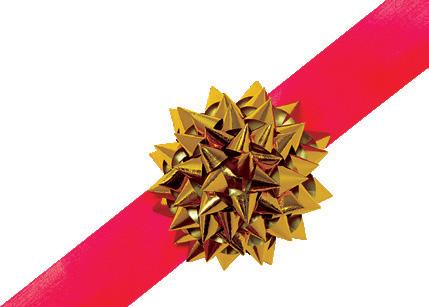
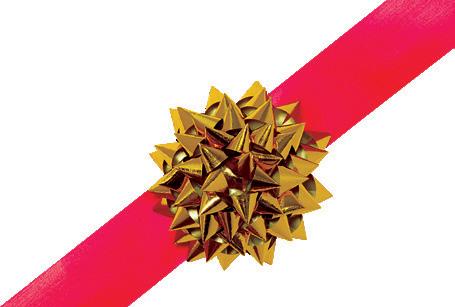
Melanie was raised on a farm on the banks of the Clarks Fork River in Belfry. Her life-long love of art led her to a career as a freelance graphic designer. When she’s not busy working, Melanie enjoys being with fam ily, spending time with her dogs, camping, ATVing, collecting rocks and watching the sunset. Check out her art at www.melaniefab.com.
BRIAN D’AMBROSIO
WRITER
Brian is the author of more than 10 books and his articles have been published in local, regional and national publications. In addition to jour nalism, Brian works as a licensed private investigator in Montana and Kansas. He may be reached at dambrosiobrian@hotmail.com
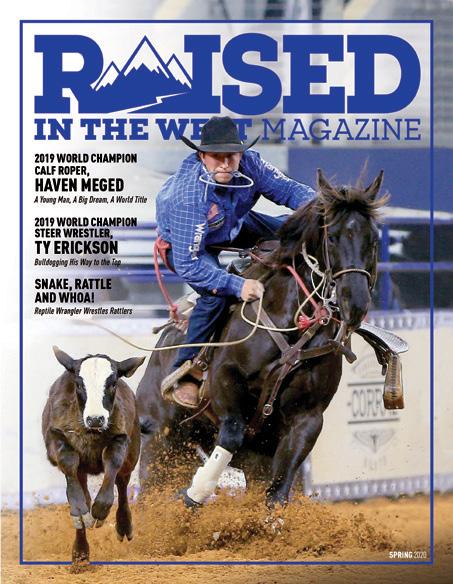

JEAN PETERSEN
WRITER
Jean is a cookbook and children’s picture book author, freelance writer and has been a weekly columnist with Western Ag Reporter for over 15 years. She and her husband live near the Beartooth Mountains in Red Lodge with their four children. Most days she can be found outdoors with her animals or on a hike, at her children’s activities, or cozying up writing and reading. You can find her at www.jeanpetersen.com
KAYLA WALKER
WRITER/PHOTOGRAPHER
Originating from a fifth-generation Montana ranch, Kayla has a real con nection to the agriculture industry and the cherished western lifestyle synonymous with the state. This upbringing is what drives here to excel in her current position as Western Ag Report Editor and nonstop position as an ag communicator. Whether it be through photography, writing, social media, or design, she strives to share the story of this way of life on a day to day basis. Keep up with her work at www.ranchraisedmedia.com or by following Ranch Raised Media on Facebook and Instagram.
KAREN GROSZ WRITER
Growing up in the shadow of Mt. Rushmore gave Karen an appreciation of high ideals. Living in Alaska for 25 years gave her a frontier spirit. Life in Montana finds her building community. A self-described “multipoten tialite,” she loves coaching others with her business, Canvas Creek Team Building.

STU HOEFLE
JACK OF ALL TRADES
Stu is a photographer, editor, title twister and number cruncher. He’s also an encourager, entertainer and travel partner. He helps with story lines, asks great questions, and looks at every angle. When he’s not helping with the magazine, he’s helping someone else. He can be found with a fishing rod, a camera or a packed bag and promises, or threatens that he’s going to disappear someday to a sandy beach with a grass hut, an endless river or a mountain top…he won’t say which.
MICHELE PEDERSEN PHOTOGRAPHER
Cover photo, and contributor to Clark family story and Out & About. Leave one line space between that and her bio.
Michele grew up on the Brinkel farm near Broadview., MT, where she learned the value of work and the generosity of a good neighbor. Four years ago, she started Pedersen Photography shooting portraits; seniors, weddings and couples. Her husband, Greg is her biggest fan and provides entertainment on almost every shoot. She also works with her 91 year old father making wooden frames in his workshop. She has two wonderful stepsons, Bryce and Nik that keep life full. Follow her on Facebook at Pedersens Photography.
Cyd Hoefle • 406.860.0292 publisher@raisedinthewest.com CALL TODAY TO ADVERTISE! Give the Gift that Lasts an Entire Year! ••••••••••••SEND $20 TO •••••••••••• RITW, PO Box 80267, Billings, MT 59108 and we will send a card to you to give to them. • A SUBSCRIPTION TO • peryear (4 issues) Your loved one can expect an issue to arrive in their mailbox with each season for only $20 8 // www.raisedinthewest.com
 DEAN MONTANA
WRITTEN BY CYD HOEFLE // PHOTOGRAPHY BY STU HOEFLE
DEAN MONTANA
WRITTEN BY CYD HOEFLE // PHOTOGRAPHY BY STU HOEFLE
10 // www.raisedinthewest.com
WHEN TRIALS BECOMEBlessingS
RYLE CLARK HAS CAPTURED HIS FAMILY’S HEART
Along the foothills of the Beartooth Mountains, near the base of Fishtail Butte, sprawls a beautiful cattle ranch where Ryan and Lindsey Clark are raising their cattle and their kids. A pasture full of cows and calves are scattered along the lane leading up to the ranch house.
An immaculate place, the buildings are all painted and well cared for, the massive yard mowed and trimmed, the woodpile stocked and the garden bountiful.
“There’s always something to do,” Ryan said. “We have an ongoing list that never seems to end.”

Ryan and Lindsey work side by side on the ranch and as often as possible, the kids are helping, too. On this beautiful fall day, after spending most of it helping neighbors prepare for shipping, the family returned home to continue a fencing project. At the end of the full day, while their parents relaxed on the deck, the children used up their remaining energy chasing each other around the yard.
When the girls, Lainey, 10 and Harper, 2, finally petered out and took a break, 6-year-old Ryle dragged his bright-orange, bouncy riding horse out to the middle of the yard. Dressed in his signature black cowboy hat, boots and spurs, Ryle settled on the back of his “horse.” He loosened his lariat rope and started making a loop. Concentrating hard, he opened the loop up as he swung. Letting go, the loop landed easily around the horns of the miniature mechanical roping steer.
Ryle laughed and yelled out to his mother, “Mom!”
ensuring that she saw his accomplishment.
“Good job, Ryle,” she called back to him.


After catching the steer, he turned his horse in the opposite direction and bounced away until the rope was taut. He jumped off, wrestled the steer onto its side and threw his hands in the air.


“He’s watched a lot of rodeos on TV,” Lindsey explained as she and Ryan laughed. “He loves all of the events: team roping, bull riding, steer wrestling.”
It’s easy to see that Lindsey and Ryan are in their element. Married for 12 years, the couple met at MSU in Bozeman. Ryan was working and Lindsey was finishing her master’s degree. They hit it off immediately. Before long, their love, mutual interest in cattle ranching and the combination of both of their cow herds lead to a humorous invitation to their wedding, which announced that “two herds would become one…”
“From there, it didn’t take long for us to triple our cow herd and our family,” Lindsey joked. Two years after they were married, daughter Lainey came along, and in the next eight years Ryle and Harper joined the family.
As perfect as the scene appears now, the Clarks went through a very rough trial when Ryle was born.
“I was hospitalized for two weeks with preeclampsia before he was born,” Lindsey said. “It’s hard enough to be in the hospital for that long, but to be that far from home was terrible.” As the doctors monitored
WINTER 2020 // 11
her high blood pressure, they decided to induce her several weeks before her due date.
“It was a really hard time,” Ryan agreed. “February, mid-winter. Lainey was staying with her grandmother and I was in the middle of calving. It was miserable, cold, snowy, and I was going for days without much sleep. One night it was so cold I was putting newborn calves in the back of the pickup to get them to the warmth of the barn and I fell asleep driving and got stuck. I ended up walking back to the house. I was so physically exhausted.” What Ryan felt physically as he worked at the ranch would be nothing compared to what would come next.
Lindsey was induced and Ryle was born at 34 weeks weighing just 4 lbs. 11 oz. He was a perfectly beautiful baby, and Lindsey and Ryan were thrilled that they had the boy they hoped for. But shortly after his birth, that thrill turned to fear as it was determined that Ryle was born with Down syndrome.
“It rocked us for sure,” Lindsey said, tears filling her eyes. “So many emotions, anger, fear and shock and the question why? And then guilt for even thinking that.”
“I was numb,” Ryan said, “I was exhausted from everything. With the added stress of worrying about Lindsey, I was so numb I

didn’t know how to respond.” Ryan paused for a moment before he continued, “That’s hard to believe, because look at Ryle now. I can’t imagine not having him in our lives.”
As soon as Ryle’s “rodeo” was over the family walked down to the horse barn. Ryle showed off the horses, the horse barn and the calving shed. He then scrambled into the chute and made it known that he was a calf needing to be branded. His father, laughed, jumped into the game, tagged Ryle’s ear, gave him a shot and branded his hip. Ryle bellered like a calf and the family all laughed.




“He brings us so much joy,” Lindsey said with a smile. “What was the hardest time in our lives became the greatest blessing. Those first few years were hard but now it’s hard to believe we even struggled. We reached a point where he was no longer “Ryle with Down syndrome,” he was just Ryle. He is who he is.”
Ryan added that they received great encouragement from a couple who also have a Down syndrome child. “He told me, ‘Treat Ryle like you treat the other kids.’ That’s probably the best advice I could have ever received. Because that’s what we do.”
Lainey is exceptional help with both of her younger siblings. Acting almost as the third parent, she watches over Ryle carefully while
“What was the hardest time in our lives became the greatest blessing... We reached a point where he was no longer “Ryle with Down syndrome,” he was just Ryle. He is who he is.”
— LINDSEY CLARK
CLARK FAMILY, LINDSEY, RYAN, LAINEY, HARPER AND RYLE
PHOTO BY MICHELE PEDERSEN
12 // www.raisedinthewest.com

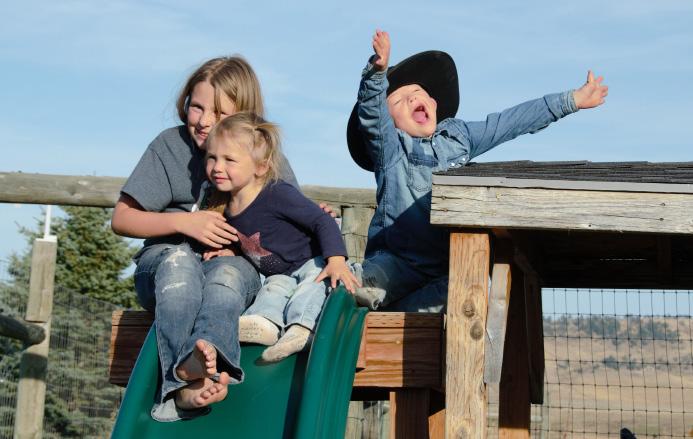



WINTER 2020 // 13
at school and on the bus ride the two of them take to Absarokee and back, every day.
“The full days can be hard on him,” Lindsey said. “He couldn’t do it without Lainey.”
The school provides speech therapy for Ryle, and he uses sign language and his own hand motions. There’s no doubt he’s figuring out how to communicate. He’s learning to speak more clearly all the time and he’s started reading sight words. The Clarks are thankful for the programs the school is providing for Ryle and the attention he receives.
“They are wonderful with him,” Lindsey said. “We’re very fortunate.”
After the “branding,” Ryle, who only knows one speed — fast — ran to the corrals. The steel pole fence and gates and the solid paneled chute, with a concrete walkway, make working cattle safe even with kids.

“Lainey and Ryle are really good help,” Lindsey continued. “We loved having them home when school was closed last spring.”
Once again Ryle’s imagination took off as he “herded” cows in the chute.



“He goes all day at that pace,” Lindsey laughed. “He keeps all of us on our toes. We are so thankful that God allowed us to be his parents.” Ryan agreed and the two of them shared a smile. They stepped back and watched as all three children raced around the corrals, the family dogs chasing them, their laughter echoing across the yard.
“If we could go back to the day he was born and have the choice of a normal baby, we wouldn’t do it,” Ryan said. “The world needs more kiddos like Ryle. He’s always happy and smiling and he loves everyone. God made Down syndrome kids perfect. It’s the rest of us that are flawed! If everyone looked at the world like they do, we wouldn’t be in the trouble we’re in.”
“God made Down syndrome kids perfect. It’s the rest of us that are flawed! If everyone looked at the world like they do, we wouldn’t be in the trouble we’re in.”
— RYAN CLARK
14 // www.raisedinthewest.com








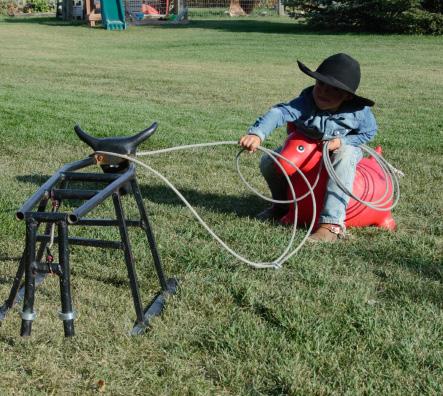


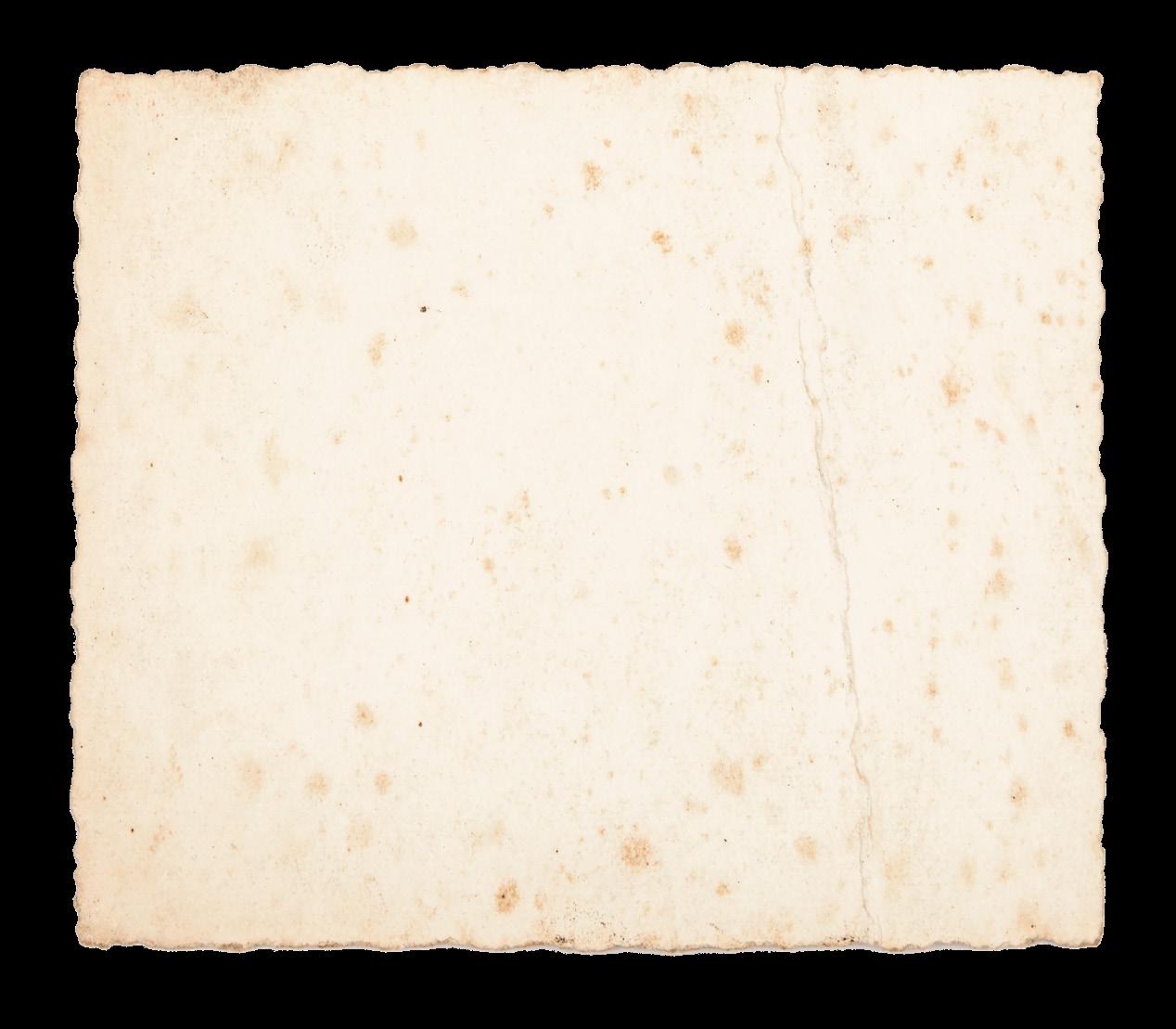

WINTER 2020 // 15
Jean’s C uisines
• CARMEL CORN
• 6 quarts popped corn
• 2 cups brown sugar
• ½ white Karo syrup
• 1 teaspoon salt
• ½ teaspoon baking soda

• 1 teaspoon vanilla
• 2 sticks butter
DIRECTIONS: Pop-popcorn and let cool evenly across a baking sheet. Combine brown sugar, Karo syrup, salt and butter in a saucepan and bring to a slow-rolling boil for five minutes. Be careful, this combination will be hot and can spurt out of the saucepan once it begins to boil. After five minutes, add baking soda and vanilla into the saucepan combination. Stir slowly until the soda and vanilla are stirred evenly. Remove from heat. Pour combination over the popcorn on the baking sheet. Toss the sugar combination to coat the popcorn, lightly and evenly, then bake in the oven at 250 degrees for 35 minutes. Remove from oven and let cool.

• Sprinkles of any kind
DIRECTIONS: Line table or countertop with wax paper. In a microwavable dish, break 3-4 chunks of your choice of almond bark off the main log of almond bark and place in the microwavable dish. Melt almond bark in slow increments in the microwave, 20-30 seconds at a time. Once it is melted, dip the candy canes into the almond bark and remove to wax paper, and quickly add sprinkles. The almond bark will harden fast.

Heat your choice of hot chocolate, and add the candy cane covered treat as the stirrer.
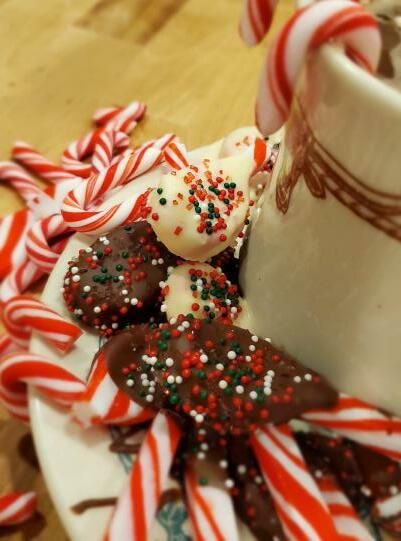
LET’S EAT WRITTEN BY JEAN PETERSEN
•
HOT CHOCOLATE • STICKS •
• Hot Chocolate Mix • Candy canes • White or Dark Almond Bark
• Wax paper 16 // www.raisedinthewest.com




 BY NICK JONDRO
BURKE
BY NICK JONDRO
BURKE
SHAWMUT MONTANA WRITTEN BY KAYLA WALKER // PHOTOGRAPHY
& CONTRIBUTED BY JARED
FOUNDATION a hunt to remember MONTANA OUTFITTER TAKES OPPORTUNITY TO CATER TO DISABLED VETERANS 18 // www.raisedinthewest.com
Between the setting moon quickly approaching the Crazy Mountains and the rising sun filling the wide-open prairie with light, two side-by-sides made their way up a two-track road to the crest of the rimrocks. Each UTV carried camouflaged hunters, sticking out with their splash of orange, and an excitement so strong it was almost tangible.
In the lead, Wes Sargent, Cayuse Hills Outfitters owner, operator, and guide, pointed to bunches of mule deer and stopped to let his hunter, Paul Heimann, glass them through his binoculars. Following along, John Burke and Nick Jondro, with the Jared Burke Foundation, and Paul’s friend, Stan Kampwerth, enjoyed the views and silently judged which buck they predicted Paul would pick.
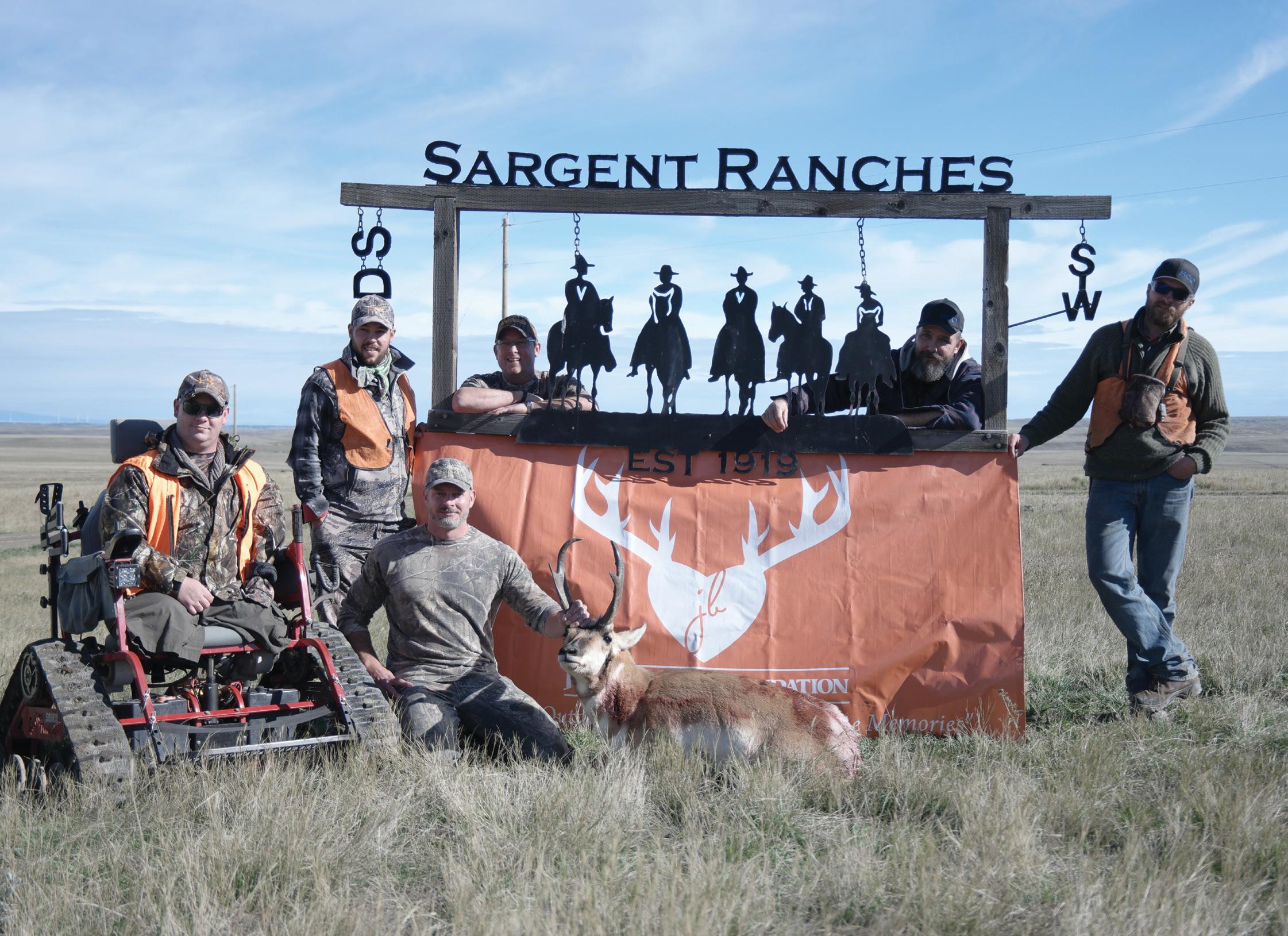
What appeared to be a typical Montana fall morning, with hunters scattering across public lands and outfitters and guides escorting their clients to a selection of private land trophies, was actually much more than that. Paul, now in his mid-70s, served in the Vietnam War, where he was decorated for his bravery.
“We went to Vietnam in August of 1965,” Paul said. “We actually got in one good-sized battle, they called it the Battle of Suoi Tre. We just about got overrun. Not quite five minutes later — we were fighting for four hours — a mechanized unit came in and bailed
us out. They saved us.”
The battle was on March 21, 1967. According to the National 4th Infantry Division Association, our American soldiers were outnumbered 10 to 1 by the enemy, but by the grace of God, they declared victory in this battle. Over 650 enemy soldiers were killed in the Battle of Suoi Tre at the cost of 51 Americans and over 200 wounded warriors.
“I guess that was the worst day of my life,” Paul recalled after a long pause.
Back at the hunter’s headquarters, as he looked out the window and across the pasture as far as the eye could see, the peacefulness helped quickly change the solemn tone that had set in in the room. And after a quiet moment of reflection, the inevitable “hunt story” shifted him from memories to plans for a celebration dinner, complete with grilled steaks and a glass of Maker’s Mark.
“It was outstanding,” Paul said of the hunt. “Wes did a super job. How many bucks did we see?”
At that point, John jumped in, noting the excitement just minutes into the hunt: “That first one, Paul said, ‘Oh, that one’s a nice one.’ Wes said, ‘No, we’re not going to shoot the first thing we
 WES SARGENT OF CAYUSE OUTFITTERS AND HIS FIRST SET OF VETERAN GUESTS, 2018
WES SARGENT OF CAYUSE OUTFITTERS AND HIS FIRST SET OF VETERAN GUESTS, 2018
WINTER 2020 // 19
see.’ That’s a good guide.”
It was fortunate he made Paul hold out a bit longer. The stars aligned and within an hour of leaving the hunter’s quarters, they had their eyes on the four-point buck Paul was sure he wanted to take home.
“He was about 300 yards, right?” Paul asked Wes as he shared the rest of the story.
Wes nodded and said, “Yep.” “That’s the furthest I’ve ever shot,” Paul said.
It was a sure shot though. By mid-morning, the team was back to the house, carcass hanging on the meat pole and the trophy antlers carefully stored away in the freezer for mounting.

Cayuse Hills Outfitters, south of Shawmut, Montana, is well equipped to handle a variety of hunts, including antelope, mule deer and even elk. The country available to Wes and Lydia Sargent’s clients can be rough and rugged, fit for experienced hunters, or open and sprawling for beginning hunters or even those with disabilities making hiking difficult.
Wes was born and raised in the Cayuse Hills so has extensive knowledge of the wildlife they hold and the patterns of most the deer, elk, and antelope in the area. When he isn’t hunting the land, he works alongside his parents on the 100-year-old ranching operation.
This makes Cayuse Hills Outfitters a great match for hunts offered through the Jared Burke Foundation. John Burke started the
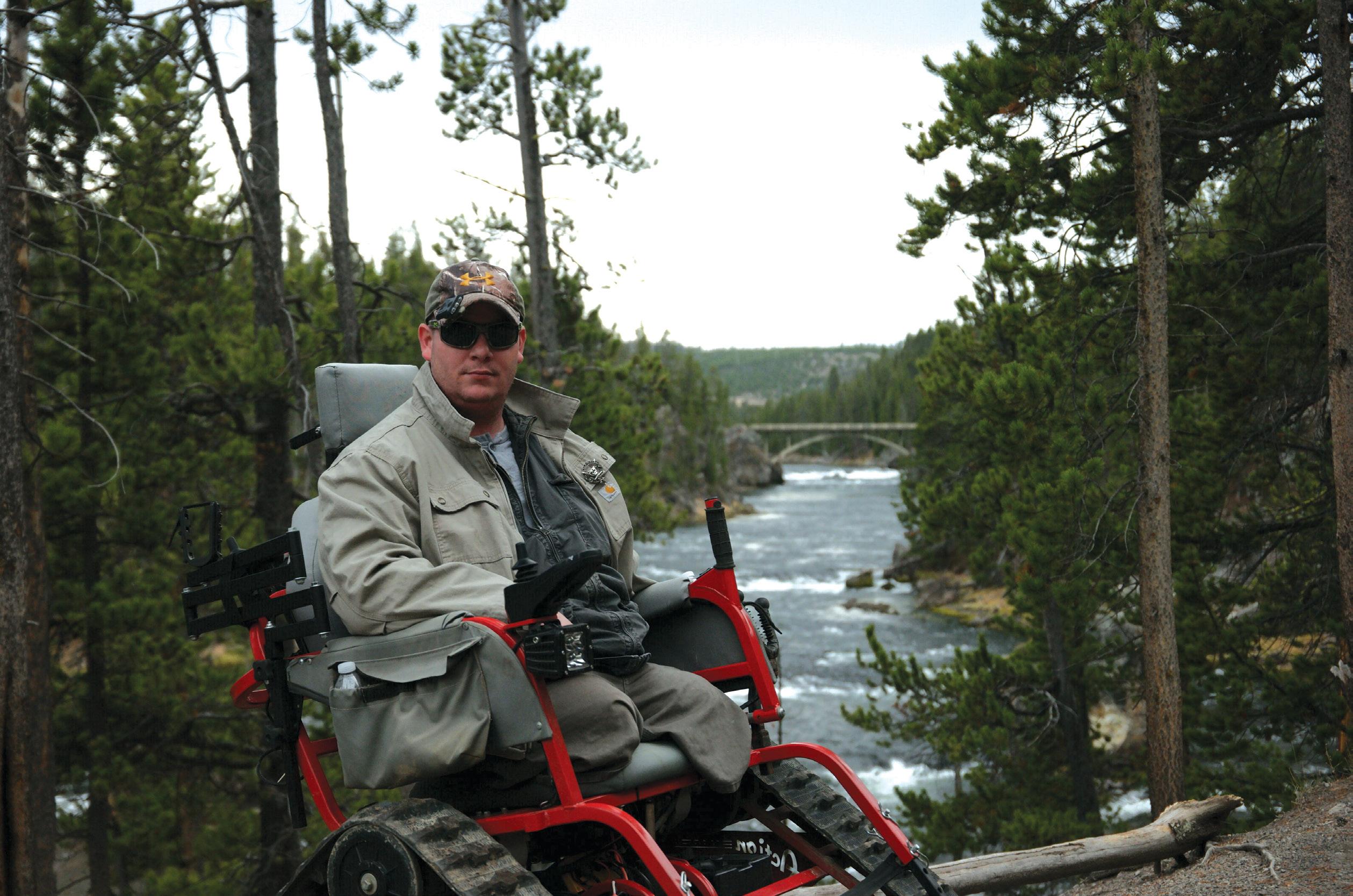 THE JARED BURKE FOUNDATION CATERS TO DISABLED AND DISADVANTAGED VETS
THE JARED BURKE FOUNDATION CATERS TO DISABLED AND DISADVANTAGED VETS
“I wanted to do things for those less fortunate because anybody can go on a hunt or outdoor adventure. But guys like Paul, they went through hell and they deserve this and much more in my eyes. So, I cater to the veterans and to the disabled and disadvantaged.”
— JOHN BURKE
STAN KAMPWERTH, JOHN BURKE, PAUL HEIMANN AND WES SARGENT
10.
20 // www.raisedinthewest.com



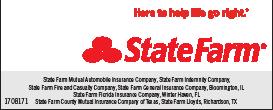
 PAUL HEIMANN, A VIETNAM VET SCORES ON HIS HUNT WITH WES SARGENT OF CAYUSE OUTFITTERS
PAUL HEIMANN, A VIETNAM VET SCORES ON HIS HUNT WITH WES SARGENT OF CAYUSE OUTFITTERS
WINTER 2020 // 21
foundation in memory of his brother, Jared, who died in a hunting accident. Rather than letting the tragedy of the accident be a constant agony, John wanted to turn it into something positive.
“People say you could’ve let that tragedy go and just be a tragedy, but I wanted to do something better,” John said. “Jared deserved it.”
So, since 2014, he has been arranging hunts for disadvantaged hunters all across the country.
“I wanted to do things for those less fortunate because anybody can go on a hunt or outdoor adventure,” John said. “But guys like Paul, they went through hell and they deserve this and much more in my eyes. So, I cater to the veterans and to the disabled and disadvantaged.”
Upholding the foundation’s mission to “promote hunter safety and enable disadvantaged hunters to turn their outdoor adventures into lasting lifetime memories,” John is also passionate about teaching hunter safety to young and beginning hunters. He emphasizes how just a moment in time could quickly become a life-altering decision, so that knowing proper hunter safety could potentially save a life.
It was on an elk hunt in Jardine, Montana, that John met Wes’ father-in-law, Lloyd Johnson, owner and operator of Specimen Creek Outfitters. The mountains just outside of Yellowstone National Park offer a much different, and somewhat more challenging hunt, not always suitable for disabled hunters. But John knew a triple amputee veteran, wounded in Afghanistan, who wanted to hunt antelope. And through the Jared Burke Foundation, John was determined to make what seemed a nearly impossible feat a reality for his friend.
That’s when Lloyd suggested an antelope hunt at Cayuse Hills Outfitters. The more open country was better suited for hunting via an all-terrain wheelchair equipped with tracks. The partnership between Cayuse Hills Outfitters and the Jared Burke Foundation was born after that first successful hunt, and since then, two other veterans have harvested their dream trophies with Wes.

The partnership is a win-win-win, John explained. Getting out and enjoying the wide-open spaces and the thrill of a Montana hunt offers much-needed relief to many of the veterans John knows. John knows that a hunt at Cayuse Hills Outfitters will fit the needs of his foundation hunters who may not be able to handle a traditional hiking hunt. And Wes earns the satisfying reward of giving back to those who served our country.

“It’s cool to give someone an opportunity that they might not otherwise have,” Wes said. “The appreciation you get from somebody that maybe doesn’t get those kinds of opportunities is really what I do this for. Not everybody can just buy a hunt and to have a foundation like this for people like Paul is so neat. It makes me feel good to be able to provide that opportunity for someone.”
Particularly with the turmoil that came with 2020, those in the room all agreed that the sense of giving and helping one another made for a particularly special hunt that day.
“Somewhere along the line, we’ve lost the importance of giving back to one another and we need to get it back now more than ever,” John said. “And doing this, this is a good thing for everybody involved.”
WES SARGENT SCOPES FOR THE BIG BUCK AS THE HUNTERS LOOK ON.
22 // www.raisedinthewest.com
“The appreciation you get from somebody that maybe doesn’t get those kinds of opportunities is really what I do this for.It makes me feel good to be able to provide that opportunity for someone.”
 — JOHN BURKE
— JOHN BURKE
for more information about



visit cayusehillsoutfitters.com and folLow on for more information about



Burke Foundation visit jaredburkefoundation.com and folLow on

Cayuse Hills Outfitters
Jared
WINTER 2020 // 23
 MELSTONE MONTANA
WRITTEN BY CYD HOEFLE // PHOTOGRAPHY BY GEORGE MCBROOM JR., JACKIE JENSEN , JENAE MARIE & SHELBY VEZAIN
MELSTONE MONTANA
WRITTEN BY CYD HOEFLE // PHOTOGRAPHY BY GEORGE MCBROOM JR., JACKIE JENSEN , JENAE MARIE & SHELBY VEZAIN
24 // www.raisedinthewest.com
unbridled Courage

to walk again
J.R. VEZAIN’S STORY OF DETERMINATION AND SPIRITUAL STRENGTH
“We’ll get through this,” J.R. Vezain said to his young wife. “Whatever it takes.”
Those were the first words J.R. spoke to his wife, Shelby, after the bareback riding accident two years ago that paralyzed him from the waist down.
Through the entire ordeal, from the moment J.R. knew that the horse he was riding was going to fall on him, until today, two years later, the couple have claimed God’s presence, promises and plans on their lives.

It was close to the end of the 2018 rodeo season. As a past prorodeo rookie of the year and six-time qualifier at the NFR, J.R. was in the 13th or 14th place, on the bubble, fighting to stay in the top 15 spots with several other cowboys. He was on the top of his game, physically, emotionally and mentally. Winning in Pasadena would secure him a coveted position at the National Rodeo Finals.

He’d drawn the horse Brazos Bash, a young mare with only one showing on the PRCA. When the clock started, she and J.R. came out of the chute strong. The mare had bucked a couple of times when suddenly she bumped back into the chute, reared straight up and flipped over backward. Her body crushed J.R.
“I remember everything,” he said. “I knew the second she broke my back. Then she rolled away from me, and when she jumped up, she stomped me right in the gut. I couldn’t breath and the pain was the worst I’d ever felt. I went to sit up and couldn’t move my legs. I didn’t know how bad it was, but I knew it wasn’t good.”
Air-lifted to a top-ranked critical care hospital in Houston, J.R. underwent emergency surgery when it was determined that his T9 and T10 vertebrae were broken. Amazingly he suffered no broken ribs or internal injuries from being stomped on—a medical miracle in itself.
WINTER 2020 // 25
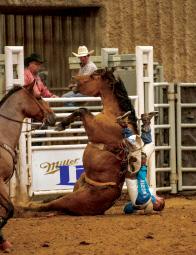 A FRACTION OF A SECOND BEFORE J.R. WAS HURT.
PHOTO BY GEORGE MCBROOM JR.
A FRACTION OF A SECOND BEFORE J.R. WAS HURT.
PHOTO BY GEORGE MCBROOM JR.
26 // www.raisedinthewest.com
“I was hysterical,” Shelby, who was back home, said. “I couldn’t get a flight out until 7 the next morning and I didn’t see J.R. until that next afternoon. We had just found out I was pregnant, and I was an emotional wreck. Still, every time I took the time to pray, God would give me peace.”
Three days after the wreck and surgery to insert rods into J.R.’s back to fuse his spine together, he got real with the doctors.
“Just how bad is it?” he asked.
The doctors told him, “It’s as bad as it could be without severing the spine. You have a slim to slight chance of ever walking again.”

J.R. replied to them, “I can take a slim to slight chance. That gives me something to work with.”

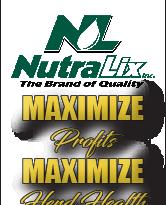
He spent days in ICU, and then was transferred to begin physical therapy. He was determined. When the people in occupational therapy thought they would need a week to teach him how to adapt to life in a wheelchair, he took a day. When physical therapy set goals for him to achieve in a week’s time, he did them in
a few days.



Being an athlete helped. Working out regularly, his body strength was at its height. Even today, his upper body strength is amazingly strong. But it’s his faith, he says, that sustains him.



“I remember the verses that were going through my head as I laid in the hospital,” he said. “Romans 8:28, James 1: 2-4, Jeremiah 29:11, all of them reminded me that God has a plan for me, and He is going to help me through this every step of the way.”
Shelby agreed. “I spent my entire pregnancy in the hospitals with J.R.. We prayed against morning sickness those first few months and continually for a healthy baby, and God answered both prayers.”
After a month in Houston, J.R. and Shelby headed to Salt Lake City where he endured five more months of rehabilitation. With rehab in the morning and afternoons free, J.R. found a new hobby in leatherwork with someone who offered to let him use his shop. He took advantage of that and
 THE SOURCE OF J.R. AND SHELBY’S FAITH AND HOPE, HIS WORD
THE SOURCE OF J.R. AND SHELBY’S FAITH AND HOPE, HIS WORD
“God has a plan for me, and He is going to help me through this every step of the way.”
— J.R. VEZAIN
WINTER 2020 // 27
honed his talent. Today, in addition to ranching, he tools purses, spurs and breast collars and has had hundreds of orders.
After six months of being away from home, the couple returned to the Newman family ranch at Melstone, arriving just before the birth of their son, Ryatt.




Looking back over the first year, both J.R. and Shelby describe what they say is “God’s fingerprint all over the entire situation” and claim He set them up for this time in their lives.
In the months leading up to the accident, the couple had been doing a Bible study called “Coming to My Senses,” about a young man who had broken his neck in a motocross accident, leaving him paralyzed from the neck down. He was given a million-to-one odds of ever walking and after years of rehabilitation, made a 20-mile trek, on foot, across the desert.
“The timing of that study was only God,” J.R. said. “I remember telling Shelby, ‘If I ever ended up like that, I hope I’d have his attitude.’”

As the months peeled off the calendar, he continued to push himself. His in-laws transformed their garage into a gym so he could pursue a daily workout regimen.
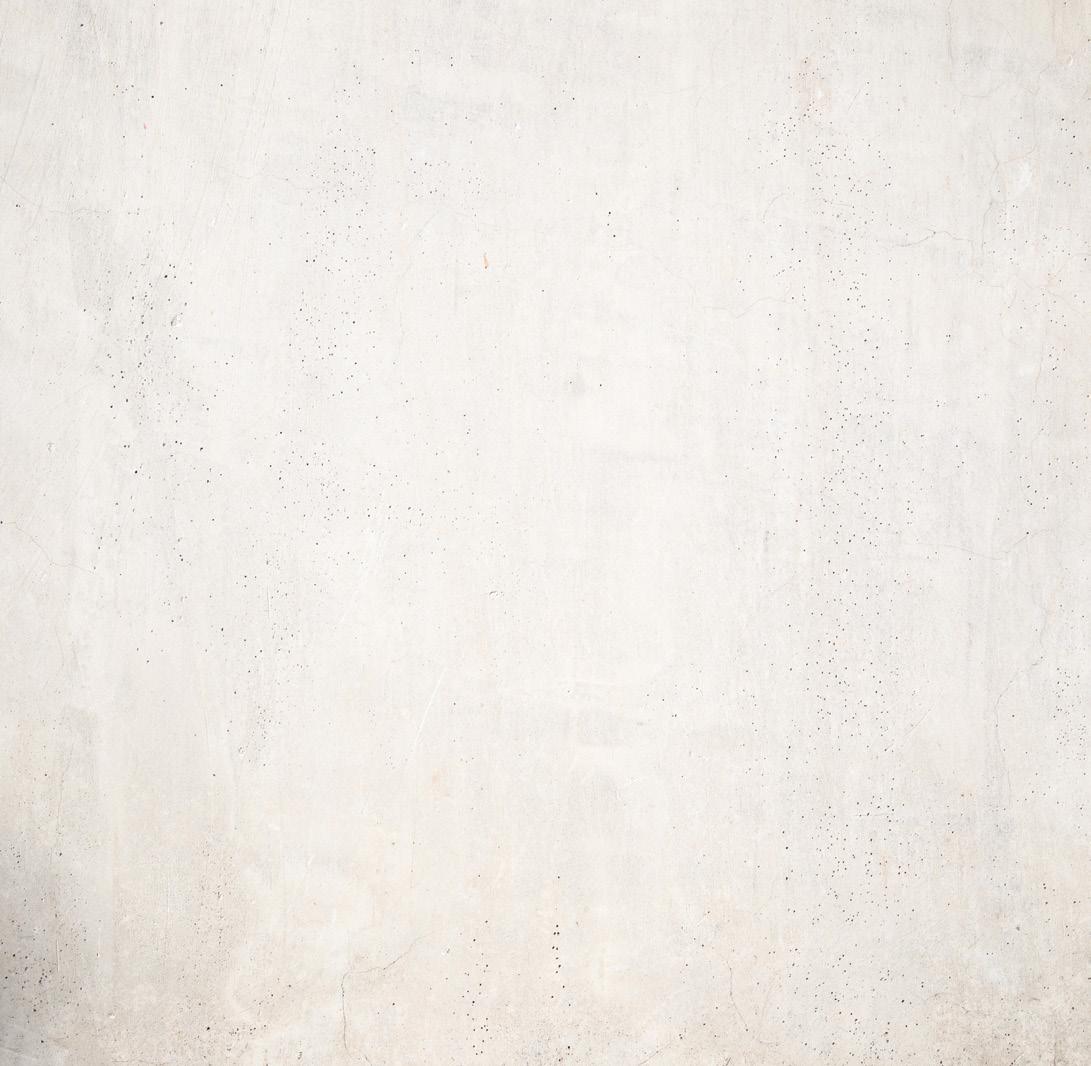
“It’s redneck for sure,” he laughed. “But the attitude of our family is, ‘How can we make this easier for everyone?’ Not just me, but also for everyone trying to help me.”
There are pulleys and mechanisms located around the ranch to ensure that J.R. can stay active and help out. His pickup and 4-wheeler have been modified for him to drive. His saddle has extra padding on the seat so he can spend time riding without getting sores.
He’s been able to help with calving, branding, working cows, moving cattle and shipping, and this spring he even roped calves to tag from his ATV. There’s nothing that he wants to do that he hasn’t figured out a way to do.
As a young rancher, he’s increased his sheep herd to over 1,000 head, and he and Shelby have added to their cow herd. It would be a remarkable feat for anyone J.R.’s age, 28, but even more so because of his disability.

“I wouldn’t be doing as well as a rancher if I hadn’t gotten hurt,” he said. “I know I’d still be rodeoing. This has made me refocus.”

Daily, the couple remain steadfast in their prayers for the miracle of J.R. walking again.
“It’s taking longer than I’d hope for sure,” he said. “I don’t try to put on false hope. It sucks being in a wheelchair. But every day, I get out of bed and get going. No matter how bad a day I think I might be having, I remind myself that someone out there is praying they could have what I have. There’s always

 PHOTO BY JANAE MARIE PHOTOGRAPHY
PHOTO BY JANAE MARIE PHOTOGRAPHY
28 // www.raisedinthewest.com





 J.R. STILL PUTS IN A FULL DAY AT THE RANCH
J.R. STILL PUTS IN A FULL DAY AT THE RANCH
WINTER 2020 // 29







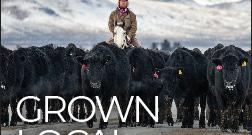


 IN 2019 J.R. WAS HONORED AT THE NFR IN LOS VEGAS PHOTOS BY JACKIE JENSEN
IN 2019 J.R. WAS HONORED AT THE NFR IN LOS VEGAS PHOTOS BY JACKIE JENSEN
30 // www.raisedinthewest.com
someone in a worse situation.”
“J.R. doesn’t feel sorry for himself,” Shelby added. “It’s obviously hard, but it could be worse. He has never asked God why He allowed this. He’s never wondered, why me? His faith is amazing.”
The Newman Ranch at Melstone has multiple family members living on it. Besides J.R. and Shelby and Shelby’s parents, there are several brothers and an uncle. The uncle is a paraplegic, resulting from a car accident in his teens. Shelby doesn’t remember him any other way. Her grandmother, who was her uncle’s caregiver, modeled for her what a caregiver looks like.
“I’ve never been uncomfortable with J.R. like this. I know what he’s capable of. We just adapt and move forward.”
— SHELBY VEZAIN
Eighteen-month-old, Ryatt, rising from his nap, toddled out of his room and climbed on his dad’s lap. J.R. hugged him and spoke to him softly before he climbed down in search of toys.
“He’s a wonderful father,” Shelby said. “I can confidently leave Ryatt with him and know I don’t have to worry. He figures out ways to do everything.”
J.R. and Shelby’s optimism, inspiration and faith have impacted thousands. J.R. posts his progress on Instagram and is followed by 18,000 people. He’s been asked to speak at rodeos, churches, camps and high schools. Telling his story helps them both.
He also has become a rodeo judge, and enjoys staying in the rodeo circle, a tightly knit group that has offered him support and help in many ways.

“We aren’t the first ones to go through this,” Shelby said, “But if we can give someone else hope, we’ll try to do that.”
Last year J.R. spoke to over 1,500 high school students at the High School Rodeo Finals in Rocksprings, Wyoming. The message he gave them was to not take anything for granted. Along with a positive message, J.R. will always bring the Gospel into his talks.
“I can’t imagine going through this without my faith in Jesus,” he said. “I’m just a broken man in a broken world trying to show people who God is.”
“J.R. doesn’t feel sorry for himself. It’s obviously hard, but it could be worse. He has never asked God why He allowed this. He’s never wondered, why me? His faith is amazing.”
check out jr's leatherwork Lazy S J Leatherworks on facebook folLow jr on instagram jrvezain
WINTER 2020 // 31
 LIVINGSTON MONTANA
WRITTEN BY BRIAN D’AMBROSIO // PHOTOGRAPHY BY K9 CARE MONTANA AND MARK CORNELISON
LIVINGSTON MONTANA
WRITTEN BY BRIAN D’AMBROSIO // PHOTOGRAPHY BY K9 CARE MONTANA AND MARK CORNELISON
32 // www.raisedinthewest.com
MORE THAN MAN’S BEST FRIEND
SERVICE DOG TRAINER TURNED HIS ADVERSITY INTO A HEALING MOVEMENT FOR OTHERS
Humble and polite in manner, David Riggs, 53, is grateful and content with a life dedicated to honoring and taking care of those who are worth honoring and taking care of.

David is the founder and CEO of K9 Care Montana (K9CM), a nonprofit agency based outside of Livingston that breeds and trains Labrador retrievers as service dogs for wounded veterans and others.
The direction of his life changed dramatically more than 35 years ago, when he was shot by a 38-caliber bullet pointblank during a dispute at a house party. He was left with a severe spinal injury that paralyzed his body below the waist. A few years later, he was diagnosed with AVN (A-vascular necrosis), a non-fatal joint deterioration and chronic pain disease. The double thump of these life-altering events provided David with a chance to learn and grow, as well as the basis for an aspiration to help others.
As it developed, it would be a Labrador retriever named Bluegrass Bourbon Fax that helped David out of the wheelchair, standing again on his own two feet, and, in due course, into a vocation that brings him and others immeasurable healing.
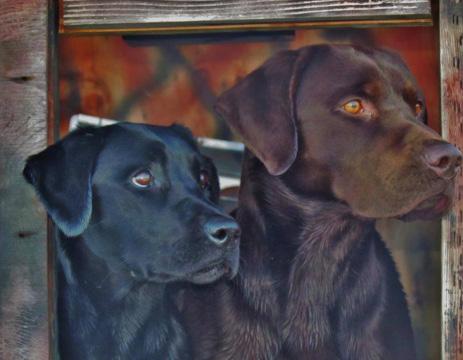
“Fax was with me when I learned to walk again and he helped me to permanently stay on my feet,” David said. “I’d basically started training my first service dog while I was learning how to walk again, years before ADA (Americans with Disabilities Act of 1990) even existed. … As injured as severely as I was, with a thoracic level injury, it shocked my spinal cord. I raised him as a
puppy, and my recovery and his help were really the birth of the business. I reached out to Project Healing Waters and donated a dog to them, and it kind of took off from there. In 1986, two years after I was shot, I started training dogs for individuals.”
Since then, David has found his life work in the training of Labrador retrievers, a highly intelligent and naturally taskoriented breed that can be taught to carry out pedestrian tasks for their owners, such as turning on a light switch or picking up an object.
David started K9CM in 2009, and since then, he has provided breeding and training services to clients locally and nationally, rooted in an educational philosophy of “praise, positive reinforcement, and repetition.” He has certified thousands of Labs and maintained and overseen a number of high-quality kennel facilities, and has participated in a vast number of UKC field trials.
“There are lots of different ways and approaches to training a service dog and I’ve found one that agrees with everybody. I implement a program of good old-fashion hard work, repetition and routine, because that’s where your consistency comes from in dog training.”
Though David never served in the military, he has found a unique purpose in his dedication to K9 Care Montana's Wounded Warrior Service Dog program.
David’s frightening stint of partial paralysis and his subsequent


WINTER 2020 // 33
recovery gave him a sense of deep empathy for people who have suffered limitations.
“I know what it’s like to experience the same things that our wounded soldiers returning from combat, who had gotten blown up or shot, have experienced,” said David, who lives with a pair of service and assistance dogs named Stormy and Griz.
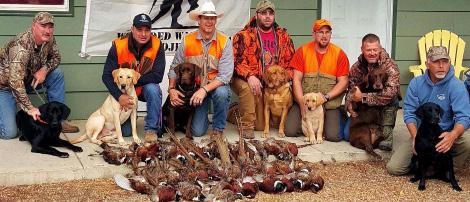
“I know all of the things that are attached to being wounded,” he continued. “It’s something that most people, thankfully, couldn’t even fathom or recognize. I think it helps our clients to know that

I’ve gone through it, too. And it helps in the initial relationship with many of these veterans. Honestly, I didn’t ever really feel like I fit in with society until I had this relationship with wounded veterans. For the first time in my life, I felt as if someone else understood me, and I somewhat understood them.”

David, fortified with such empathy and toughened by life experience, says that his service dogs are competently trained to help wounded soldiers to live diligently, attentively and with restored dignity. He perceives his function and responsibility

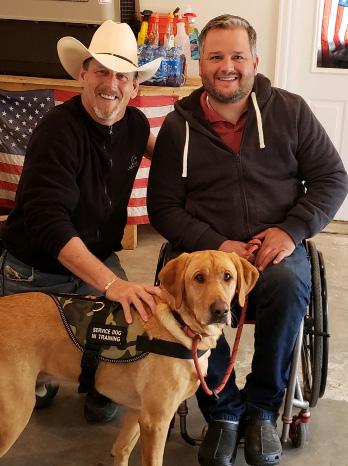 DAVID WITH A WOUNDED VET AND HIS K9CM SERVICE DOG, SAPPHIRE, ENJOYING A K9CM OUTDOOR ACTIVITY
A WOUNDED WARRIOR AND HIS DOG, GUNNER, JOIN DAVID
ANNUAL WOUNDED VETERAN PHEASANT HUNT ON THE ROCKY MOUNTAIN FRONT, VALIER, MT
DAVID WITH A WOUNDED VET AND HIS K9CM SERVICE DOG, SAPPHIRE, ENJOYING A K9CM OUTDOOR ACTIVITY
A WOUNDED WARRIOR AND HIS DOG, GUNNER, JOIN DAVID
ANNUAL WOUNDED VETERAN PHEASANT HUNT ON THE ROCKY MOUNTAIN FRONT, VALIER, MT
34 // www.raisedinthewest.com
“Honestly, I didn’t ever really feel like I fit in with society until I had this relationship with wounded veterans. For the first time in my life, I felt as if someone else understood me, and I somewhat understood them.”
— DAVID RIGGS
as parallel to a long-term unlimited resource and the entire program as an alternative approach to mental and physical recovery.




“What I’ve realized and recognized is that these vets feel like they have been forgotten all these years down the road,” he said. “Part of our job is in letting them know that they haven’t been forgotten.”
David is flexible and astute with his dog training, and he willingly customizes a service dog to fit the needs of his clients. While the vast majority of clients come from military backgrounds, the range of people who receive service dogs includes children with autism and wounded first responders. His selection process is both caring and cautious.
“I am looking for veterans who are willing to accept help as they are beginning or are in the middle of their recovery process,” he said. “Willingness plays a big part. It requires the vet or the caregiver of a vet to show interest in this approach. I like to see that they have a strong support group, family members, the VA, or another organization that they work with.”

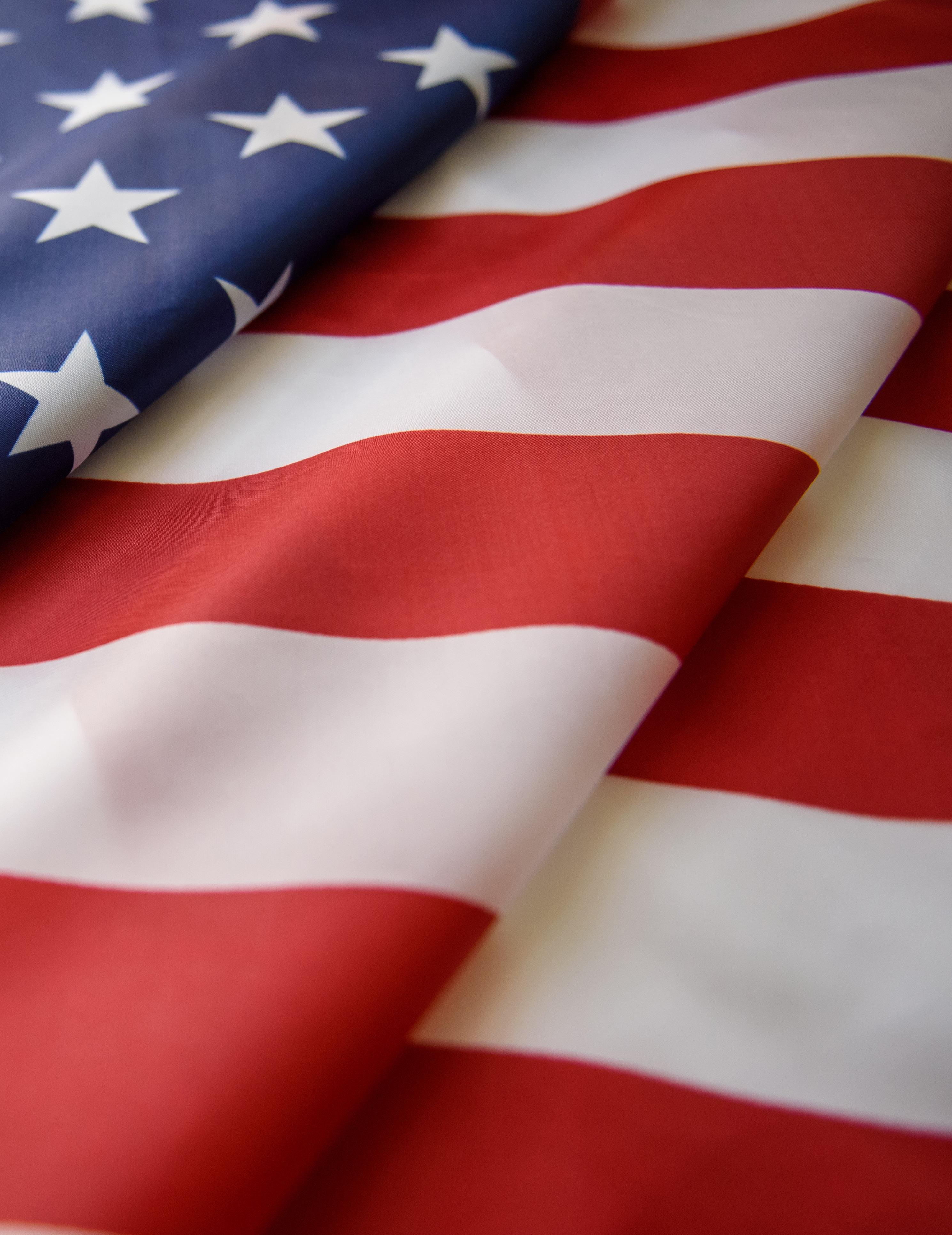
He is equally careful about the number of dogs he has the time and resources to successfully train, handle and relocate. At present, K9CM oversees approximately 80 active service dog projects in the state of Montana.

“I put out six or seven dogs a year, at the utmost, to ensure the best quality of service that I can give them,” he said.


There are two types of service dogs that David identifies. Psychiatric dogs are uniquely trained to mitigate the

WINTER 2020 // 35
effects of PTSD (Post-Traumatic Stress Disorder) and autism. Mobility dogs, such as the ones that assist David, are specially trained to help with mobility, balance, and coordination issues, such as retrieving objects or flipping a light switch on or off.
“Mobility dogs are usually also trained to fit psychiatric needs, too,” he said. “Sometimes a dog is trained for psychiatric needs, but not necessarily for mobility. There are veterans, who, to the average eye, have no visible disability. They look and walk completely normal, but they suffer from PTSD. A dog trained to mitigate the psychiatric condition of PTSD would carry out a task that helps block people from impeding on the veteran’s personal space, or from walking up behind them, and that sort of thing. Sometimes if the client is in a wheelchair, the client might have PTSD and need a dog trained to psychiatric needs, too.”
There is a plethora of resounding testimonials available from David’s clients. Feedback that spurs him to keep working hard on behalf of those who greatly require and benefit from the services he offers. David is a part of a noble community, proud to be lending physical and spiritual support to our brothers and sisters who have been maimed or compromised. While the work is arduous, his mood is light and optimistic. He knows that they will make it, and that gives him hope for himself.
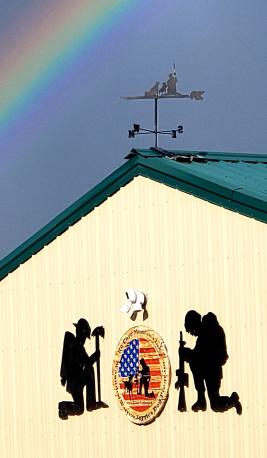

“K9 Care is trying to give wounded warriors the chance to lead and live a regular life, and all at no cost,” he said. “It’s been an interesting journey in my life. Not at all easy, but definitely rewarding. It is what I plan to dedicate the rest of my active life to.”
The incorporation of the Service Dogs sets the stage for confidence building and many other personal improvements. Recipients are selected from a strict list of requirements helping the organization to ensure that their service dog is a perfect match for their client. The client is then invited to spend time enjoying a customized outdoor experience as they get to know their dog. Because of the limited number of dogs available for training each year and the success of the program, there is currently a two-year waiting list for applicants.
Box 490,
MT 59047

FOR MORE INFORMATION, TO DONATE OR SPONSOR A VET CONTACT: K9 Care Montana, Inc, David Riggs, Founder/CEO, PO
Livingston,
or visit their website at www.k9caremontana.org K9 CARE
36 // www.raisedinthewest.com

 JOSH
KAYLENE
JOSH
KAYLENE
BOZEMAN MONTANA WRITTEN BY CYD HOEFLE // PHOTOGRAPHY CONTRIBUTED BY
AND
BAKER A STORY OF MIRACULOUS SURVIVAL AND ADORING LOVE iJosh KayleneBaker 38 // www.raisedinthewest.com
Kaylene and Josh Baker have an incredible love story, and they don’t mind sharing it. Married just one year, the Bozeman couple have endured more in their time together than most couples do in a lifetime. Their love, their faith and their story are powerful.
They met on staff four years ago at Chi Alpha, a Christian fellowship ministry at Montana State University. As mentors for MSU students, the two became good friends. A love of the outdoors inspired them to begin the sport of climbing.


“It’s great exercise,” Kaylene said. “Climbing provides a real upper-body workout. We’re not thrill seekers, but problem solvers. We like figuring out the best way to get to the top and then strategically doing it.”
The afternoon of June 30, 2018, became the date that life changed for them. On that day, the couple had chosen to climb south of Big Timber at the Natural Bridge area. Arriving mid-morning, they climbed multiple pitches before taking a break for a late lunch. By the time they decided to do their last climb, it was close to 5 p.m.
“We’d had a great day up to that time,” Josh said. “The climbs were great, we’d done well, so we decided to do one more. The reviews on it were good and it was a fairly easy climb.”
Josh was the lead climber and Kaylene was belaying for him, keeping tension on the rope so that in case of mishap, he would not fall far before being stopped by her.
“We only had one helmet that day,” Josh said. “Kaylene had it on. There’s no doubt it saved her life.”
Josh had worked his way up about 40 feet and was analyzing the route to determine what to do next. Some pebbles had fallen as he climbed, but there was no reason for him to believe for a

minute that anything bigger than that would fall. But in a freak accident, the very rock that he was straddling dislodged and fell. Right below him, Kaylene was hit full force by the five-foot slab of rock, leaving her with multiple injuries, the most severe being her left leg severed at the knee.
She remembers nothing of the accident. For Josh it’s a nightmare he will never forget.
In an instant, the whole side came loose, and he found himself in a free fall.


“It happened so fast,” he said. “There was nothing I could do. The rock hit her and kept going. I saw my girlfriend laying there face down, bleeding, and all I could think was that she was dead. I couldn’t get to her fast enough.”
As she fell, Kaylene landed on the rope, keeping the slack taut, ultimately saving Josh from falling to his death.
“I started screaming for help as I tried to jerk the rope loose so I could get down to her,” he said, tears coming to his eyes as he recalled the story. “I got to about 10 feet up and that’s as far as I could get so I unlatched my harness, jumped down and ran to her. She was moaning so I knew she was still alive. But I also knew there wasn’t much time.”
Kaylene had landed face down, which not only kept Josh from falling, but also restricted the flow of blood from her injuries and contributed to her survival. When he reached her, he pulled his sweatshirt and T-shirt off and used them to try to stop the bleeding.
“I knew I needed to get help, but I didn’t want to leave her,” he continued.
WINTER 2020 // 39
Just before the climb, they had met eight climbers around the bend from where they were. Hoping they were still in the area, Josh ran toward them, crying out for help. The group was still there, and among them was a nursing student and another who had wilderness training. They quickly fashioned a tourniquet with their belts and worked to stabilize Kaylene as two others from their group ran to their car to head for cell service. At the same time, someone who heard Josh’s yells was already racing to the nearby ranger station to radio the Big Timber Search and Rescue.
“We don’t know who that was,” Josh said. “But whoever it was got us help about a half hour before the cellphones had service enough to call. That was a miracle.”

More miracles kept mounting up that day. From the eight climbers that were still in the canyon to the person that radioed for help to the Big Timber Search and Rescue, who often use the Natural Bridge area for training. The team knew the fastest route to Kaylene and how to best get her out. As they administered oxygen to her and worked on her wounds, Josh said she came to long enough to speak.
“She just kept repeating ‘Jesus,’” he said. “I remember thinking, ‘Wow, her faith is so real that that is her response!’”



The medical helicopters from Bozeman and Billings were both in use elsewhere, so a helicopter from Helena was dispatched.


On that very day, the team from Helena had been working on traumatic injury rescues and hypothetically and miraculously used Kaylene’s exact weight to determine the type and amount of medication someone would need in such a rescue. As soon as they landed and began administering meds, they knew what she needed without further calculations.

The helicopter landed just as she was being moved across the parking lot at Natural Bridge. As she was rushed away to Billings, Josh stayed surrounded by people who were reaching out to the young man, who was clearly in shock.
A chaplain from Big Timber was on site and gave Josh a ride to Big Timber while his wife drove Josh’s car. Once they decided he was capable of heading to Billings on his own, they let him go.

“He called Kaylene’s parents and brother for me,” Josh said. “It was a relief to have someone take over and make decisions for me. I really didn’t know what to do first.”

Once Kaylene got to SCL Healthcare in

40 // www.raisedinthewest.com
Billings, the trauma team quickly took over. In addition to her leg amputation, her left hand had been crushed beyond repair, and she also sustained a traumatic brain injury and a broken back. It was a fight to keep her alive in those first few days. Josh remained as close to her as he could, and her family, from Helena, raced down to be with her.

“I’ll never forget one of the first things Kaylene’s dad said to me,” Josh said, as he teared up. “Just after they got to Billings, he put his hands on both of my shoulders and looked me straight in the eye and said, ‘We forgive you and don’t hold you responsible.’ I didn’t even realize how much I needed to hear that.”

Taking turns, the family kept vigil over Kaylene, never leaving her alone. She was kept heavily sedated to allow her body to begin healing and to help her endure the pain. Because of the bombardment of phone calls and texts in the weeks that followed, Kaylene’s family set up a Facebook page called “Prayers for Kaylene” to help friends and family members keep up with news of her progress. What was meant to be just for friends and family quickly expanded. Thousands of people stepped up and began praying for Kaylene’s recovery and followed every day of her journey.
Just days after the accident, Kaylene gave her family hope as she responded to commands to wiggle her toes and open her eyes. Prayers for miracles were asked by the family as Kaylene
 — KAYLENE BAKER
— KAYLENE BAKER

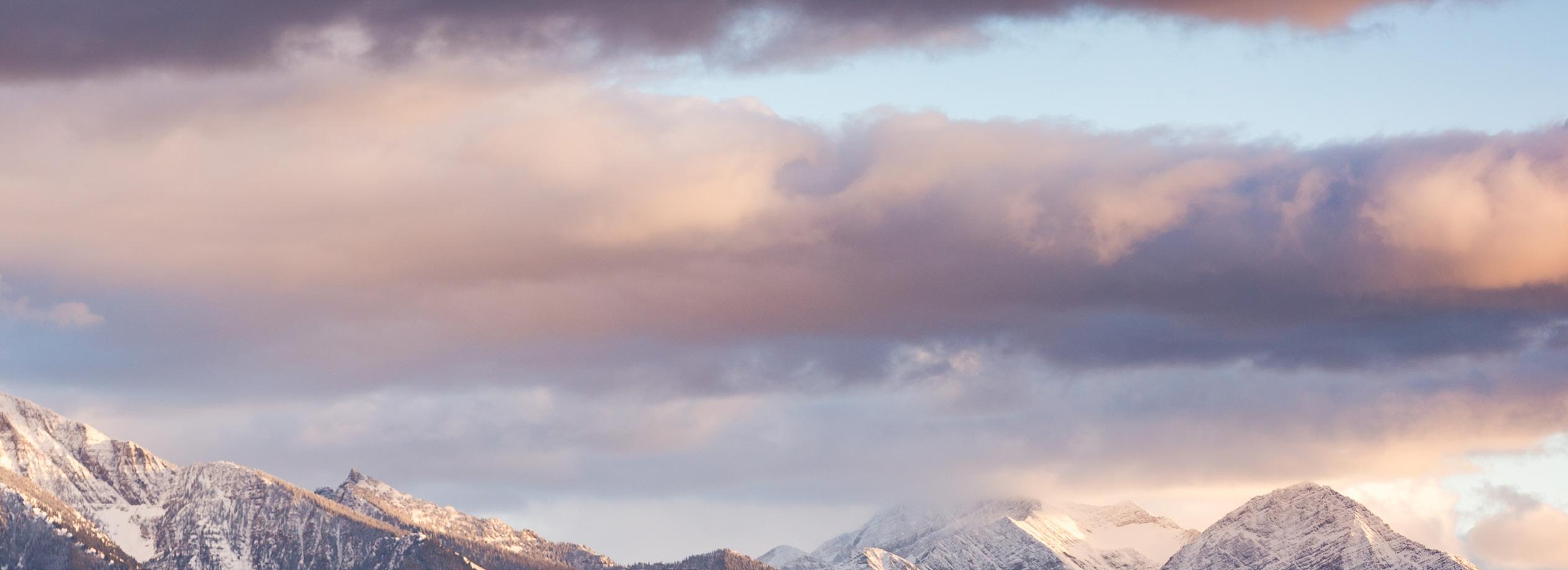
“
It’s a terrible thing that happened to me. There are difficult days for sure. But God has used what we’ve gone through to set us up for success.”
WINTER 2020 // 41
continued to fight for her life. Her injuries were extensive and the road to recovery slow. The Facebook page became an encouraging support for the family, with posts and prayers arriving from all over the United States and beyond, including Turkey, Indonesia and the Philippines. Over 5,000 people followed her progress and prayed for her recovery.
Nearly a month after the accident, Kaylene was told of the extent of her injuries.
“I just remember having a peace about it,” she said. “I had a lot of questions, but my first response was one of peace.”
She spent weeks in ICU, some time in longterm care in Billings and then in Salt Lake City for rehabilitation. Josh was with her the entire time.

“I quit school and my job in Bozeman so I could be with her,” he said. “I was where I needed and wanted to be.” Sleeping on a friend’s couch and living out of a duffle bag, his commitment drew concern from Kaylene’s family.
“I didn’t know that until a while after,” he laughed, “but I guess it was a natural concern.”

It was for Kaylene, too. When she was preparing to leave for Salt Lake, she took Josh aside. “I told him, ‘Don’t come to Salt Lake if you feel sorry for me or responsible. I don’t need that.’ I was
basically drawing a line in the sand and wanted to know what his commitment level was.”
That level was obviously high. Josh stayed by her side as she was fitted for prosthetics and learned to live her life in a new way. They married a year after her accident and today Kaylene works at her old job with Chi Alpha mentoring college-age students. She continues to strive to be independent and even drives. Josh completed school and has a master’s degree in counselling and is employed as a counselor.
“Josh is so good to me,” Kaylene said. “I’m thankful that he chose me. He knew what he was getting into and he still said ‘yes.’”
Of course, they would both say they wish the accident had never happened. Days of sorrow and discouragement do come.
“It’s a terrible thing that happened to me,” Kaylene said, “There are difficult days for sure. But God has used what we’ve gone through to set us up for success.”
In the corner of the living room, the rope that held Josh and Kaylene to each other in the climb has been framed, a reminder of what they have gone through.
“God can use our story,” Kaylene added. “We don’t want to just be an inspiration to others. We want to live our lives for Jesus and make him known.”
“I just remember having a peace about it. I had a lot of questions, but my first response was one of peace.”
— KAYLENE BAKER
42 // www.raisedinthewest.com
LIFE Well Lived
Dick Imer says, “Being optimistic is the only way to be because everything is a new experience, and you just draw on the past so you can enjoy the future.”
Dick is a well-loved coach and teacher who spent most of his career at Hardin High School. When asked if there was one student who was a stand-out, someone he is especially proud of, he said there are too many to list. It wouldn’t be fair to call out one, he said, because they all were stand-outs, in one way or another.
Dick said teaching and coaching were the most exciting parts of his life. Part of what kept it exciting was participating in life alongside his students. He often counseled them to not be “just a number” going through school. Many of the students knew they were excellent at track and basketball, winning state championships in both, and they would “save themselves” for those sports. Dick encouraged them to do something, anything, so they were always learning, always moving, because that’s what makes life exciting.
As an example from his own experience, Dick recalled the time a music teacher in Hardin encouraged him to sing with his team. She was someone that Dick “didn’t want to tangle with,” as she convinced him it would benefit his team to learn to sing, to understand the discipline, the breathing techniques. He didn’t argue, and stood right beside his team, singing with gusto, showing them, in real time, that life is for experiencing. She eventually told Dick that he should just mouth the words.

“That ended my singing career,” he said with a laugh.
Dick, 89 years old, grew up, the oldest of three children, near Chicago.

“It was a lively time,” he said. “With war manufacturing, and all sorts of comings and goings, it was quite a deal.”
His parents were divorced working people who didn’t have time to watch him in sports until later, when he became a star athlete. His athletic ability landed him a scholarship at the University of Washington, a place that really opened his eyes.
“There were over 20,000 students when I got there in 1950,” he recalled. “The place was so big and full of learning that it was really exciting.”
Still, Dick always felt like a cowboy at heart and he pined for the wide-open spaces, so he transferred to the University of Montana.
Life sometimes has a way of giving us exactly what we need, a grounding, a home away from home, and that is what Dick says he found when he met his wife, Betty. Working a summer job building railroad in Colstrip, he and the fellas would go to the cowboy dances on Friday night.
That’s where he saw Betty.
“She was the cutest one in the room, naturally!” Dick said. Then he stopped for a moment in the telling, probably imagining himself as a young man dancing with her again. Betty’s family had a ranch
WRITTEN BY KAREN GROSZ
// PHOTOGRAPHY CONTRIBUTED BY THE IMER FAMILY
RETIRED COACH AND RANCHER, DICK IMER LIVES LIFE LARGELY
HARDIN MONTANA
A
44 // www.raisedinthewest.com
near Colstrip, and a deep history there which, after they married, enabled Dick to finally be the cowboy he always wanted to be.
There was one catch however, one that has been a lifelong problem for the two of them.
Betty attended MSU in Bozeman and is a lifelong Bobcat fan. A Montana house with Bobcats and Grizzlies living in it is a house divided! Over the years, their children and grandchildren have gone to school in both Bozeman and Missoula, evening the playing field. Dick has done his best to get Betty to come around, as he joked, but she is just as loyal to her alma mater as he is to his.
This one problem aside, Dick and Betty raised three children together, Sheri Koyama, Patti Ballock and Mark Imer. They also welcomed six grandchildren into the world. Mark lost a battle to cancer several years ago, which took a toll on the family.
But Dick claims, his voice filled with emotion and pride, “It’s family that keeps us together.”
He and Betty look forward to daily conversations with their kids and grandkids. They have watched their grandchildren grow up right before their eyes and keep in touch with each of them through Facebook.
The couple, married for 67 years, recently leased out their Hardin farm and moved to Billings.
“I’m not acclimated to a life with so much concrete,” Dick said. “It was easier to be active on the farm. But if you sit too long you never get up, so I stay active.” He’s sure that he will live to be 100, as several family members have.

“If,” he said with a warm laugh, “Betty just keeps whipping me.”
Dick recalled that when he was a kid it seemed that if you lived to 60 you were an incredibly old man. Now, well past that, he feels great, and can hardly wait to get each day started, even if today’s politics give him paralysis.

Dick’s advice for his students is his advice for everyone: “Get involved in things you enjoy. You might not get an easy pass, you might not learn it the first time, but if you keep at it, you will be successful.”
Dick has obviously kept at it, in many ways, for many years, and that has made him a colorful, happy character who is living life with a smile, a laugh, and a penchant for helping the team to win the title.
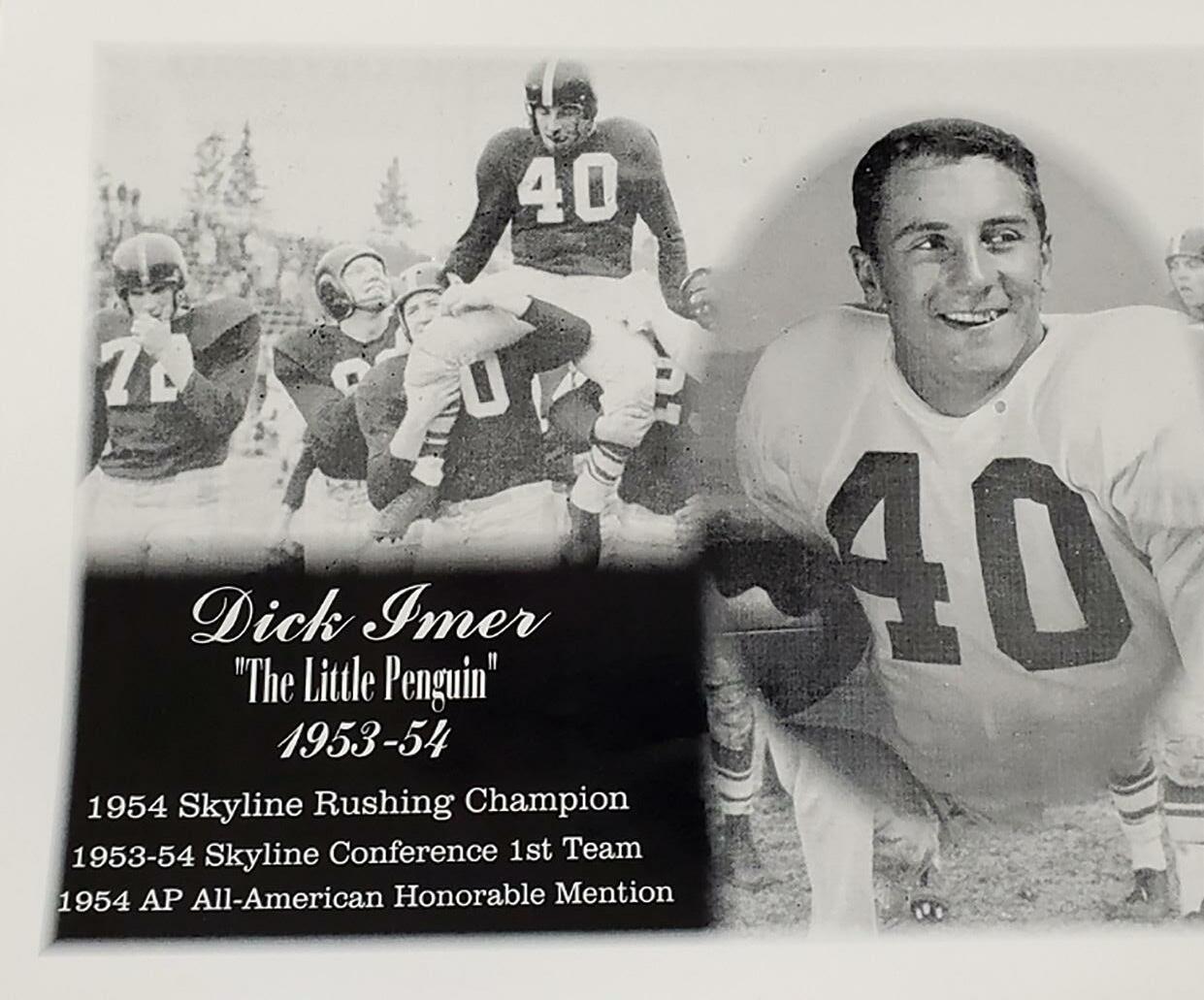
WINTER 2020 // 45
Just another Montana



CRISS CROSSING THE REGION
One last fall day before the snow sets in. Near Red Lodge.

The Episcopal church in Sheridan, MT lights up a dark night.

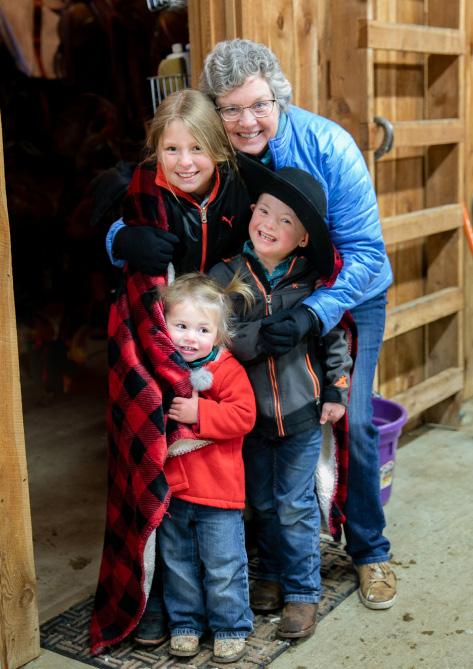
Calgary
Bust?
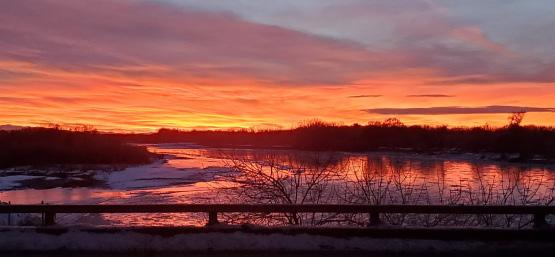 A day spent with the Clark kids is a great day! (photo by Michele Pedersen)
(photo by Michele Pedersen)
A day spent with the Clark kids is a great day! (photo by Michele Pedersen)
(photo by Michele Pedersen)
sunset. Crossing the Yellowstone River.
or
Looks like bust! Seen between Big Timber and Harlotown. You don’t have to go far to spot beautiful bucks in MT. Next door to us…
OUT ABOUT ❅❆❄❅❆❄❅❆❄ ❅❆❄❅❆❄❅❆❄❅❆❄❅❆❄ 46 // www.raisedinthewest.com
